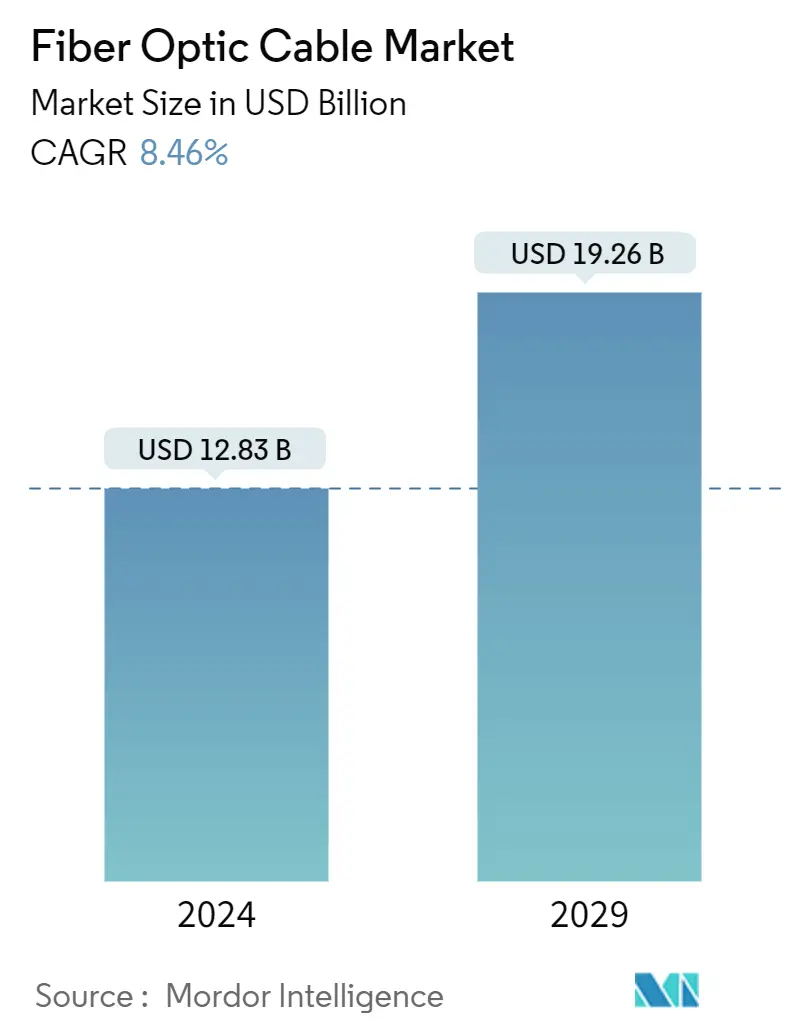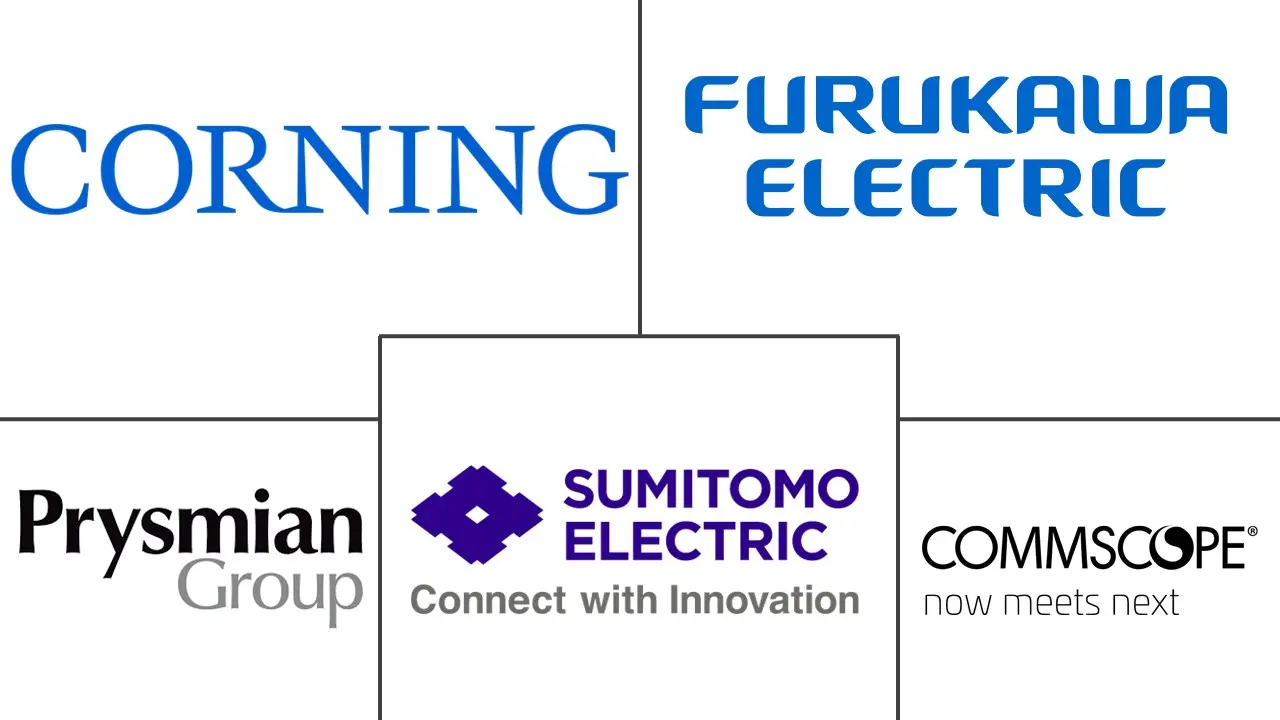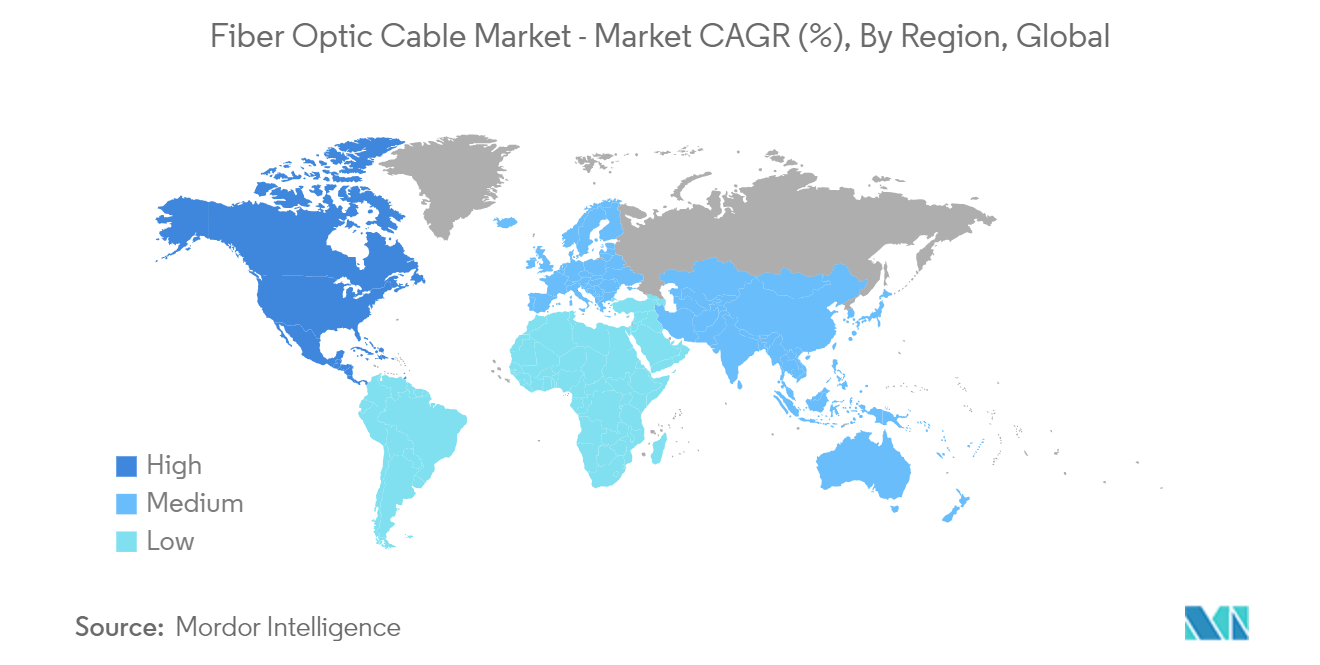Fiber Optics Cable Market Size

| Study Period | 2019-2029 |
| Market Size (2024) | USD 12.83 Billion |
| Market Size (2029) | USD 19.26 Billion |
| CAGR (2024 - 2029) | 8.46 % |
| Fastest Growing Market | North America |
| Largest Market | Asia Pacific |
Major Players
*Disclaimer: Major Players sorted in no particular order |
Fiber Optics Cable Market Analysis
The Fiber Optic Cable Market size is estimated at USD 12.83 billion in 2024, and is expected to reach USD 19.26 billion by 2029, growing at a CAGR of 8.46% during the forecast period (2024-2029).
Increased broadband penetration, rising Internet TV streaming services, and the overall growth of the telecommunications sector are the main drivers. All these factors drive the increased use of fiber optic cables.
The evolution of fifth-generation networks and fiber optic infrastructure has driven digital transformation across industries. Optic fiber cable offers better security, reliability, bandwidth, and security than copper cables. Broadband penetration, increasing Internet TV streaming services, and the overall growth of the telecommunications industry have led to a substantial increase in FTTH. But there is also the newly emerging Internet of Things and working from home movement.
Furthermore, according to Ericsson, 5G subscriptions were expected to increase globally between 2022 and 2023, rising from over 0.55 billion to over 1.67 billion. Such a huge rise in 5G subscriptions was expected to drive the market.
The growing investments in fiber optic communication expansions with the growing connectivity globally are one of the major factors contributing to the market's growth. For instance, in October 2023, the Suez Canal Economic Zone signed an agreement worth USD 18 million in investments with the Chinese power and fiber optic cable manufacturer Hengtong to expand the latter's business in the TEDA-Egypt zone. Under the agreement, it sought to manufacture fiber optic cables with a capacity of up to two million kilometers in the region. The agreement will also contribute to fulfilling its contract obligations in connection with producing fiber optic cables, optical distribution networks, and ground telecommunications. This includes, but is not limited to, optical communications engineering, wire production and power engineering services, and the operation and maintenance of submarine fiber optic cables.
Although fiber optic cable offers many benefits, such as higher bandwidth, low latency, and a higher degree of reliability and flexibility, installing these devices may cost thousands of dollars. The growing demand for connectivity for optic fiber producers in developing nations presents significant business prospects. Yet factors such as installing fiber optic cables provide several operational difficulties for the market's growth.
The COVID-19 pandemic and lockdown affected capital investments and industrial activities globally. Following the global economic recession led by COVID-19, the market witnessed slow growth in 2020 and continued in 2021. All industries, including e-commerce, banking, retail, manufacturing, and healthcare, rapidly adopted digital technologies such as artificial intelligence, cloud, and analytics to stay competitive in the market, thereby experiencing significant growth in 2022 and 2023 with substantial expansions in the fiber optic network coverage contributing to the market's growth rate during the forecast period.
Fiber Optics Cable Market Trends
Telecommunications Sector Expected to Witness Significant Growth
- The increasing demand for data traffic from various sources, such as the internet, e-commerce, computer networks, and multimedia (voice, data, and video), has led to the need for a transmission medium capable of handling higher bandwidth to handle such significant amounts of information, driving the growth of fiber optic cable in the telecom infrastructure during the forecast period.
- Additionally, in telecommunication networks, fiber optic cables are used to connect different network nodes, such as cell towers, data centers, and internet service providers, allowing for the exchange of vast amounts of data between different locations. Fiber optic cables also allowed for developing high-speed internet connections and other advanced communication technologies like video conferencing, online gaming, and cloud computing.
- Benefits associated with fiber optic cables in the context of the telecommunication industry involve high speed and bandwidth, low attenuation, immunity to electromagnetic interference, high reliability and less maintenance compared to copper cables, and difficulty in tapping or intercepting, thus facilitating high security.
- Additionally, owing to their security, scalability, and the unlimited bandwidth potential to handle the vast amount of backhaul traffic being generated, fiber optic cables are also being chosen to support the bandwidth levels catering to advanced technologies like 5G, Big Data, and IoT that rely heavily on real-time data collection and transfer, supporting the growth of Fiber optics cable expansion among the telecom players globally.
- According to the GSMA report, 5G connections were expected to surpass one billion in 2022 and two billion by 2025. By the end of 2025, 5G will account for over a fifth of mobile connections, and more than two in five people globally will live within a 5G network. Due to the increasing demand for 5G connections, many players are expanding their production capabilities. This is expected to drive the market studied significantly.

North America is Expected to be the Fastest Growing Market
- The increasing demand for fiber optic cables in North America is mainly driven by several key factors highlighting the region's emphasis on high-speed, reliable, and scalable communication infrastructure.
- North America has recently obtained a prominent position owing to the increasing pace of fiber optic deployment in the country. With data-intensive activities like video streaming, cloud computing, online gaming, and remote working, the need for high-speed and dependable internet connections has increased and according to the report released by the Fiber Broadband Association, US fiber-to-the-home (FTTH) witnessed a 13% growth in the United States in 2023 to 78 million homes, with this fiber broadband now passing nearly 69 million unique US homes.
- Also, according to the association, Canada witnessed a surge in the demand for FTTH. For instance, Canadian passings had a 12% growth in 2023 to 12.1 million. The jump in FTTH deployments results from significant government funding efforts, such as BEAD, RDOF, and ReConnect, which are beginning to have a direct effect. For instance, the Broadband Equity, Access, and Deployment (BEAD) Program provides USD 42.45 billion to expand high-speed internet access by funding planning, infrastructure deployment, and adoption programs in all 50 states, Washington DC, Puerto Rico, the US Virgin Islands, Guam, American Samoa, and the Commonwealth of the Northern Mariana Islands.
- Furthermore, as the demand grows, many companies focus on product launches, partnerships, and other strategic investments. For instance, in March 2023, CommScope announced expanding fiber-optic cable production to accelerate broadband rollout across the United States, connecting more communities and underserved areas. The lines were expected to support 500,000 homes per year in fiber-to-the-home (FTTH) deployments.
- Corning Incorporated announced its plans to expand the manufacturing capacity for optical fiber cables by constructing an all-new cable manufacturing facility in Gilbert, Arizona. The facility, expected to open in 2024, will be the industry's westernmost US manufacturing site for optical cable, allowing the company to serve the growing demand in the western United States and Canada.

Fiber Optics Cable Industry Overview
The fiber optics cable market is highly fragmented, with the presence of major players like Corning Inc., Sumitomo Electric Industries Ltd, Prysmian Group, Furukawa Electric, and CommScope Holding Company Inc. Players in the market are adopting strategies such as partnerships and acquisitions to enhance their product offerings and gain sustainable competitive advantage.
October 2023 - Yangtze Optical Fiber and Cable Joint Stock Limited announced new optical cable variants, high-density data center solutions, and streamlined F.ODN pre-connected solutions at SCTE CABLE-TEC EXPO 2023. The new all-dry fiber optic cable features a compact diameter, reduced weight, and splice-ready design without filling compounds. It is optimized for swift, hassle-free deployment.
September 2023 - Coherent Corp. announced its partnership with Windstream to enable 400G services has been extended to enable 100G services at the edge of the network, leveraging the industry’s first 100G QSFP28 0 dBm digital coherent optics (DCO) transceiver.
Fiber Optics Cable Market Leaders
-
Corning Inc.
-
Sumitomo Electric Industries Ltd
-
Prysmian Group
-
Furukawa Electric
-
CommScope Holding Company Inc.
*Disclaimer: Major Players sorted in no particular order

Fiber Optics Cable Market News
- October 2023 - Sterlite Technologies Ltd (STL) announced that the company had developed a 160-micron optical fiber, among the world’s slimmest fiber for telecommunication. This innovation was conceptualized and developed indigenously at STL’s Centre of Excellence in Maharashtra. With this launch, the company has become the first to develop and patent this technology globally.
- September 2023 - Coherent Corp. announced that the company had launched the first pump laser module with 1200 mW of output power in a 10-pin butterfly package. Rapid advances in optical communications technologies are reaching the theoretical limits of fiber-optic capacity and driving the expansion of transmission windows into the extended C- and L-bands.
Fiber Optic Cable Market Report - Table of Contents
1. INTRODUCTION
- 1.1 Study Assumptions and Market Definition
- 1.2 Scope of the Study
2. RESEARCH METHODOLOGY
3. EXECUTIVE SUMMARY
4. MARKET INSIGHTS
- 4.1 Market Overview
-
4.2 Industry Attractiveness - Porter's Five Forces Analysis
- 4.2.1 Threat of New Entrants
- 4.2.2 Bargaining Power of Consumers
- 4.2.3 Bargaining Power of Suppliers
- 4.2.4 Threat of Substitute Products
- 4.2.5 Intensity of Competitive Rivalry
- 4.3 Assessment of the Impact of and Recovery from COVID-19
5. MARKET DYNAMICS
-
5.1 Market Drivers
- 5.1.1 Increasing Penetration of Internet and High Data Traffic
- 5.1.2 Increasing Adoption of 5G and FTTX
- 5.1.3 Rising Number of Data Center Facilities
-
5.2 Market Challenges
- 5.2.1 High Cost of Installation and Associated Complexities
- 5.3 Analysis of Pricing and Pricing Trends
- 5.4 Technology Roadmap
6. MARKET SEGMENTATION
-
6.1 By End-user Industry
- 6.1.1 Telecommunication
- 6.1.2 Power Utilities
- 6.1.3 Defense/Military
- 6.1.4 Industrial
- 6.1.5 Medical
- 6.1.6 Other End-user Industries
-
6.2 By Geography
- 6.2.1 North America
- 6.2.2 Europe
- 6.2.3 Asia-Pacific
- 6.2.3.1 China
- 6.2.3.2 Japan
- 6.2.3.3 India
- 6.2.3.4 Malaysia
- 6.2.3.5 Indonesia
- 6.2.3.6 Thailand
- 6.2.3.7 Vietnam
- 6.2.3.8 Singapore
- 6.2.3.9 Philippines
- 6.2.3.10 Rest of Asia-Pacific
- 6.2.4 Latin America
- 6.2.5 Middle East and Africa
7. COMPETITIVE LANDSCAPE
-
7.1 Company Profiles*
- 7.1.1 Corning Inc.
- 7.1.2 Sumitomo Electric Industries Ltd
- 7.1.3 Prysmian Group
- 7.1.4 Furukawa Electric
- 7.1.5 CommScope Holding Company Inc.
- 7.1.6 Coherent Corporation
- 7.1.7 Finolex Cables Limited
- 7.1.8 Proterial Cable America Inc. (Proterial Ltd)
- 7.1.9 Sterlite Technologies
- 7.1.10 Yangtze Optical Fiber and Cable Joint Stock Ltd Co.
8. INVESTMENT ANALYSIS
9. FUTURE OUTLOOK OF THE MARKET
** Subject To AvailablityFiber Optics Cable Industry Segmentation
Fiber optic technology utilizes highly flexible, transparent fiber of extruded glass or plastic to transmit data. Fiber optic cables incorporate glass threads as thin as human hair, transmitting messages modulated into light waves. Although these cables are made of glass, they are highly durable and malleable.
The fiber optic cable market is segmented by end-user industry (telecommunication, power utilities, defense/military, industrial, medical, and other end-user industries) and by geography (North America, Europe, Asia-Pacific [China, Japan, India, Malaysia, Indonesia, Thailand, Vietnam, Singapore, Philippines, and the rest of Asia-Pacific], Latin America, Middle East and Africa). The study tracks the key market parameters, underlying growth influencers, and major vendors operating in the industry, which supports the market estimations and growth rates during the forecast period. The study also tracks the revenue accrued from the various types used in various end-use industries globally. In addition, the study provides the global fiber optic cable market trends and key vendor profiles. The study further analyses the overall impact of COVID-19 on the ecosystem. The market sizes and forecasts are provided in terms of USD value for all the above segments.
| By End-user Industry | Telecommunication | |
| Power Utilities | ||
| Defense/Military | ||
| Industrial | ||
| Medical | ||
| Other End-user Industries | ||
| By Geography | North America | |
| Europe | ||
| Asia-Pacific | China | |
| Japan | ||
| India | ||
| Malaysia | ||
| Indonesia | ||
| Thailand | ||
| Vietnam | ||
| Singapore | ||
| Philippines | ||
| Rest of Asia-Pacific | ||
| Latin America | ||
| Middle East and Africa |
Fiber Optic Cable Market Research Faqs
How big is the Fiber Optic Cable Market?
The Fiber Optic Cable Market size is expected to reach USD 12.83 billion in 2024 and grow at a CAGR of 8.46% to reach USD 19.26 billion by 2029.
What is the current Fiber Optic Cable Market size?
In 2024, the Fiber Optic Cable Market size is expected to reach USD 12.83 billion.
Who are the key players in Fiber Optic Cable Market?
Corning Inc., Sumitomo Electric Industries Ltd, Prysmian Group, Furukawa Electric and CommScope Holding Company Inc. are the major companies operating in the Fiber Optic Cable Market.
Which is the fastest growing region in Fiber Optic Cable Market?
North America is estimated to grow at the highest CAGR over the forecast period (2024-2029).
Which region has the biggest share in Fiber Optic Cable Market?
In 2024, the Asia Pacific accounts for the largest market share in Fiber Optic Cable Market.
What years does this Fiber Optic Cable Market cover, and what was the market size in 2023?
In 2023, the Fiber Optic Cable Market size was estimated at USD 11.74 billion. The report covers the Fiber Optic Cable Market historical market size for years: 2019, 2020, 2021, 2022 and 2023. The report also forecasts the Fiber Optic Cable Market size for years: 2024, 2025, 2026, 2027, 2028 and 2029.
Fiber Optic Cable Industry Report
Statistics for the 2024 Fiber Optic Cable market share, size and revenue growth rate, created by Mordor Intelligence™ Industry Reports. Fiber Optic Cable analysis includes a market forecast outlook to 2029 and historical overview. Get a sample of this industry analysis as a free report PDF download.



